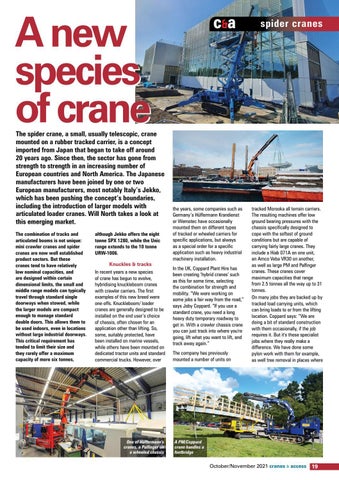A new species of crane
The spider crane, a small, usually telescopic, crane mounted on a rubber tracked carrier, is a concept imported from Japan that began to take off around 20 years ago. Since then, the sector has gone from strength to strength in an increasing number of European countries and North America. The Japanese manufacturers have been joined by one or two European manufacturers, most notably Italy’s Jekko, which has been pushing the concept’s boundaries, including the introduction of larger models with articulated loader cranes. Will North takes a look at this emerging market.
The combination of tracks and articulated booms is not unique: mini crawler cranes and spider cranes are now well established product sectors. But these cranes tend to have relatively low nominal capacities, and are designed within certain dimensional limits, the small and middle range models can typically travel through standard single doorways when stowed, while the larger models are compact enough to manage standard double doors. This allows them to be used indoors, even in locations without large industrial doorways. This critical requirement has tended to limit their size and they rarely offer a maximum capacity of more six tonnes,
although Jekko offers the eight tonne SPX 1280, while the Unic range extends to the 10 tonne URW-1006. Knuckles & tracks In recent years a new species of crane has begun to evolve, hybridising knuckleboom cranes with crawler carriers. The first examples of this new breed were one-offs. Knuckleboom/ loader cranes are generally designed to be installed on the end user’s choice of chassis, often chosen for an application other than lifting. So, some, suitably protected, have been installed on marine vessels, while others have been mounted on dedicated tractor units and standard commercial trucks. However, over
One of Hüffermann’s cranes, a Palfinger on a wheeled chassis
c&a
the years, some companies such as Germany’s Hüffermann Krandienst or Wemotec have occasionally mounted them on different types of tracked or wheeled carriers for specific applications, but always as a special order for a specific application such as heavy industrial machinery installation. In the UK, Coppard Plant Hire has been creating ‘hybrid cranes’ such as this for some time, selecting the combination for strength and mobility. “We were working on some jobs a fair way from the road,” says Joby Coppard. “If you use a standard crane, you need a long heavy duty temporary roadway to get in. With a crawler chassis crane you can just track into where you're going, lift what you want to lift, and track away again.” The company has previously mounted a number of units on
spider cranes
tracked Morooka all terrain carriers. The resulting machines offer low ground bearing pressures with the chassis specifically designed to cope with the softest of ground conditions but are capable of carrying fairly large cranes. They include a Hiab 071A on one unit, an Amco Veba VR30 on another, as well as large PM and Palfinger cranes. These cranes cover maximum capacities that range from 2.5 tonnes all the way up to 31 tonnes. On many jobs they are backed up by tracked load carrying units, which can bring loads to or from the lifting location. Coppard says: “We are doing a bit of standard construction with them occasionally, if the job requires it. But it's those specialist jobs where they really make a difference. We have done some pylon work with them for example, as well tree removal in places where
A PM/Coppard crane handles a footbridge
October/November 2021 cranes & access
19



















